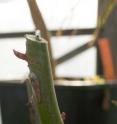Embedding microchips in ornamental shrubs
Radiofrequency Identification (RFID), or microchip technology, has been used for years in animal identification systems and is now being tested for use in plants. Researchers note that microchip techniques have varied applications for plants. The technology can be used to help guide visitors through parks and botanical gardens, to thwart theft of valuable plants, and to aid scientists and growers in monitoring plant health. For example, RFID codes have been used successfully with grapevines to create databases and to generate ''virtual gardens'' in which production, monitoring, global positioning system coordinates, and other data are archived. Microchips have traditionally been attached externally, which can change the aesthetics of plants. Researchers in Italy have designed a new way to tag shrubs by imbedding microchips, thus minimizing damages to plants' appearance. According to a study published in HortTechnology, the method is a desirable way to tag ornamental shrubs. "Plant tagging using radiofrequency identification (RFID) microchips is attractive for ornamental shrubs such as rose due to their high market value, wide distribution, health certification system, and numerous uses", explained corresponding author Andrea Luvisi.
To test the effects of embedding microchips in roses, the scientists tagged two cultivars and performed observations of tissues around the microchip and growth analysis of plant canes. Results showed that microchip implantation did not cause xylem necrosis in 8- to 9-mm-diameter canes, but wilt of the lateral shoot and negative impacts on growth were observed in lower diameter canes compared to control plants. The tagged roses were tracked by a database developed for rose information, field log, and botanical sheet retrieval.
The findings suggested that rose plants can be safely tagged with a RFID microchip as early as the nursery phase without negative effects on plant appearance. "As opposed to other woody species for which methods of microchip implantation have been tested, rose tagging offers the possibility of insertion within canes of less than 10 mm diameter, such as those typically found in the rose nursery setting", noted Luvisi. "Moreover, the possibility of tagging after grafting without changing common plant production procedures and aesthetic value are important considerations."
The researchers added that their database has the capacity to track tagged plants from the nursery to maturity through multiple applications.
Source: American Society for Horticultural Science
Other sources
- Embedding microchips in ornamental shrubsfrom Science DailyTue, 5 Jul 2011, 16:32:06 UTC
- Embedding microchips in ornamental shrubsfrom PhysorgTue, 5 Jul 2011, 14:30:37 UTC
